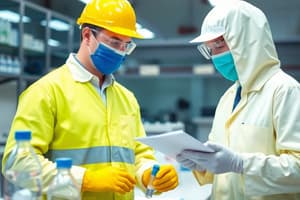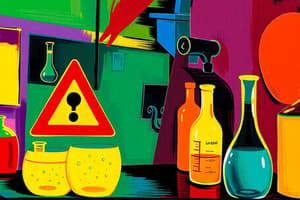Podcast
Questions and Answers
What is the primary focus of personal protective equipment (PPE) in a laboratory setting?
What is the primary focus of personal protective equipment (PPE) in a laboratory setting?
- To reduce the need for safety training
- To protect the user from potential hazards (correct)
- To provide comfort during long working hours
- To enhance the aesthetic appearance of the laboratory
Which of the following is NOT a key component of effective emergency response protocols in the laboratory?
Which of the following is NOT a key component of effective emergency response protocols in the laboratory?
- Chemical waste disposal methods (correct)
- First aid measures
- Emergency shutdown procedures
- Evacuation procedures
What is the main goal of risk assessment in a laboratory environment?
What is the main goal of risk assessment in a laboratory environment?
- To reduce waste generation
- To ensure high productivity levels
- To identify and mitigate potential hazards (correct)
- To assess employee performance
Which action should be taken first during a laboratory emergency requiring evacuation?
Which action should be taken first during a laboratory emergency requiring evacuation?
How can laboratory personnel contribute to the continuous improvement of safety practices?
How can laboratory personnel contribute to the continuous improvement of safety practices?
What is one of the consequences of failing to adhere to safety regulations in the lab?
What is one of the consequences of failing to adhere to safety regulations in the lab?
In a laboratory safety training video, which aspect of PPE usage was highlighted as critical?
In a laboratory safety training video, which aspect of PPE usage was highlighted as critical?
Which of the following statements reflects a common understanding related to laboratory safety?
Which of the following statements reflects a common understanding related to laboratory safety?
What is one of the risks associated with equipment hazards?
What is one of the risks associated with equipment hazards?
Which color sign indicates mandatory actions in the laboratory?
Which color sign indicates mandatory actions in the laboratory?
Which type of hazard is associated with poorly designed workstations?
Which type of hazard is associated with poorly designed workstations?
What should be worn to protect against chemical spills?
What should be worn to protect against chemical spills?
What is one essential guideline for maintaining Personal Protective Equipment (PPE)?
What is one essential guideline for maintaining Personal Protective Equipment (PPE)?
What category of hazard involves respiratory issues due to inhalation of harmful substances?
What category of hazard involves respiratory issues due to inhalation of harmful substances?
What is the primary purpose of evacuation protocols in a laboratory setting?
What is the primary purpose of evacuation protocols in a laboratory setting?
Which type of hazard is most likely to result from prolonged exposure to loud noises?
Which type of hazard is most likely to result from prolonged exposure to loud noises?
What type of health effect can occur immediately after exposure to hazardous chemicals?
What type of health effect can occur immediately after exposure to hazardous chemicals?
Which of the following is NOT considered a chemical hazard in the laboratory?
Which of the following is NOT considered a chemical hazard in the laboratory?
What is a primary reason for adhering to safety protocols in a laboratory setting?
What is a primary reason for adhering to safety protocols in a laboratory setting?
Which procedure is recommended to maintain a safe laboratory environment?
Which procedure is recommended to maintain a safe laboratory environment?
Which type of hazard involves exposure to flammable chemicals?
Which type of hazard involves exposure to flammable chemicals?
What is the first step in managing laboratory risks according to safety protocols?
What is the first step in managing laboratory risks according to safety protocols?
Which of the following practices should be avoided in a laboratory to ensure safety?
Which of the following practices should be avoided in a laboratory to ensure safety?
Which type of hazard is associated with sharp objects and high temperatures?
Which type of hazard is associated with sharp objects and high temperatures?
What is the purpose of an MSDS?
What is the purpose of an MSDS?
Which of the following is true about emergency showers?
Which of the following is true about emergency showers?
Which piece of emergency equipment is specifically designed to protect against fire hazards?
Which piece of emergency equipment is specifically designed to protect against fire hazards?
What should be included in an incident report after an accident?
What should be included in an incident report after an accident?
What is an essential requirement for first aid kits in laboratories?
What is an essential requirement for first aid kits in laboratories?
What is a key action to take during a laboratory evacuation?
What is a key action to take during a laboratory evacuation?
Why is regular maintenance of laboratory equipment important?
Why is regular maintenance of laboratory equipment important?
What should be done if a chemical reacts unfavorably to water during a spill?
What should be done if a chemical reacts unfavorably to water during a spill?
What does chronic toxicity typically result from?
What does chronic toxicity typically result from?
Which of the following best describes acute toxicity?
Which of the following best describes acute toxicity?
Which factor does NOT significantly influence an individual's susceptibility to toxic substances?
Which factor does NOT significantly influence an individual's susceptibility to toxic substances?
What is the LD50 commonly used to measure?
What is the LD50 commonly used to measure?
Local injuries from chemical exposure are primarily associated with what type of chemicals?
Local injuries from chemical exposure are primarily associated with what type of chemicals?
How is the concentration in air that kills half of a population expressed?
How is the concentration in air that kills half of a population expressed?
What can cause systemic injuries from toxic substances?
What can cause systemic injuries from toxic substances?
Which of the following is an example of an acute effect of a substance?
Which of the following is an example of an acute effect of a substance?
Flashcards are hidden until you start studying
Study Notes
Importance of Health and Safety
- Safety protocols are crucial to prevent accidents and ensure well-being in a laboratory environment.
- Regulations and standards ensure safe laboratory practices.
Risk Assesment
- Identify types of potential hazards in the laboratory environment:
- Chemical hazards: exposure to toxic chemicals, corrosive substances, flammable materials.
- Biological hazards: exposure to pathogenic microorganisms, viruses, bacteria.
- Physical hazards: sharp objects, high temperatures, electrical equipment.
- Radiation hazards: ionizing radiation, ultraviolet light.
- Fire and Explosion Hazards: flammable chemicals, faulty electrical equipment.
- Equipment Hazards: malfunctioning machinery, improper use of tools.
- Noise Hazards: loud equipment, machinery noise.
- Ergonomic Hazards: poorly designed workstations, repetitive tasks.
- Ventilation and Respiratory Hazards: poor air quality, exposure to fumes.
- Biomechanical Hazards: awkward postures, lifting heavy objects.
- Assess severity and likelihood of risks in the laboratory environment.
- Implement control measures to reduce identified risks.
Personal Protective Equipment (PPE)
- Minimum recommended PPE includes chemical resistant gloves, splash proof goggles, lab coat, face shield, and rubber apron when necessary.
- Correct procedures for donning and doffing PPE contribute to individual safety and overall laboratory well-being.
- Regularly inspect and maintain PPE to make sure it remains in good condition.
Emergency Procedures
- Familiarize yourself with evacuation protocols and assembly points in the laboratory.
- Understand basic first-aid measures for common laboratory injuries.
- Report accidents and incidents using a standardized incident report form.
Laboratory Equipment Safety
- Proper handling, usage, and regular maintenance of laboratory equipment are crucial to prevent accidents.
- Familiarize yourself with emergency shutdown procedures in case of equipment malfunction.
Chemical Safety
- Follow procedures for handling and storing chemicals.
- Material Safety Data Sheets (MSDS) should be available for all laboratory chemicals.
Toxic Effects of Chemical Exposure
- The effects of chemical exposure depend on various factors like dose, concentration, frequency, and duration of exposure.
- Local injuries involve the area of contact, typically caused by corrosive chemicals.
- Systemic injuries affect tissues or organs, occurring when toxins reach them through the bloodstream.
- Distinguish between acute and chronic chemical exposure and toxicity.
- Most toxicity estimates are derived from animal studies and may not directly correlate to humans.
- LD50 (lethal dose 50) is used to measure toxicity in animals.
Susceptibility to Toxic Substances
- Individual susceptibility to toxic substances varies based on factors such as:
- Nutritional habits, physical condition, obesity, medical conditions, drinking and smoking, and pregnancy.
Studying That Suits You
Use AI to generate personalized quizzes and flashcards to suit your learning preferences.




